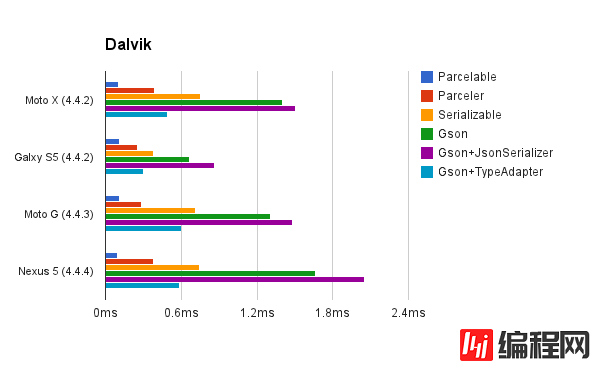Android中,Activity和Fragment之间传递对象,可以通过将对象序列化并存入Bundle或者Intent中进行传递,也可以将对象转化为JSON字符串,进行传递。
Android中,Activity和Fragment之间传递对象,可以通过将对象序列化并存入Bundle或者Intent中进行传递,也可以将对象转化为JSON字符串,进行传递。
序列化对象可以使用Java的Serializable的接口、Parcelable接口。转化成jsON字符串,可以使用Gson等库。
1.Serializable
public class Author implements Serializable{
private int id;
private String name;
//...
}
public class Book implements Serializable{
private String title;
private Author author;
//...
} 传递数据
Book book=new Book();
book.setTitle("Java编程思想");
Author author=new Author();
author.setId(1);
author.setName("Bruce Eckel");
book.setAuthor(author);
Intent intent=new Intent(this,SecondActivity.class);
intent.putExtra("book",book);
startActivity(intent); 接收数据
Book book= (Book) getIntent().getSerializableExtra("book");
Log.d(TAG,"book title->"+book.getTitle());
Log.d(TAG,"book author name->"+book.getAuthor().getName()); 2.转化为JSON字符串
public class Author{
private int id;
private String name;
//...
}
public class Book{
private String title;
private Author author;
//...
}
传递数据
Book book=new Book();
book.setTitle("Java编程思想");
Author author=new Author();
author.setId(1);
author.setName("Bruce Eckel");
book.setAuthor(author);
Intent intent=new Intent(this,SecondActivity.class);
intent.putExtra("book",new Gson().toJson(book));
startActivity(intent);
接收数据
String bookJson=getIntent().getStringExtra("book");
Book book=new Gson().fromJson(bookJson,Book.class);
Log.d(TAG,"book title->"+book.getTitle());
Log.d(TAG,"book author name->"+book.getAuthor().getName()); 3.使用Parcelable
实现Parcelable接口需要实现两个方法
describeContents方法。内容接口描述,默认返回0就可以; writeToParcel方法。将传递的数据打包到Parcel容器中。除了要实现这两个方法还必须创建一个Parcelable.Creator接口的实例,用于读取Parcel容器中的数据
public class Author implements Parcelable{
private int id;
private String name;
//setter & getter...
@Override
public int describeContents() {
return 0;
}
@Override
public void writeToParcel(Parcel dest, int flags) {
//该方法将类的数据写入外部提供的Parcel中.即打包需要传递的数据到Parcel容器保存,
// 以便从parcel容器获取数据
dest.writeString(name);
dest.writeInt(id);
}
public static final Creator<Author> CREATOR=new Creator<Author>() {
@Override
public Author createFromParcel(Parcel source) {
//从Parcel容器中读取传递数据值,封装成Parcelable对象返回逻辑层。
Author author=new Author();
author.setName(source.readString());
author.setId(source.readInt());
return author;
}
@Override
public Author[] newArray(int size) {
//创建一个类型为T,长度为size的数组,仅一句话(return new T[size])即可。方法是供外部类反序列化本类数组使用。
return new Author[size];
}
};
}
public class Book implements Parcelable{
private String title;
private Author author;
//setter & getter...
@Override
public int describeContents() {
return 0;
}
@Override
public void writeToParcel(Parcel dest, int flags) {
dest.writeString(title);
dest.writeParcelable(author,flags);
}
public static final Creator<Book> CREATOR=new Creator<Book>() {
@Override
public Book createFromParcel(Parcel source) {
Book book=new Book();
book.setTitle(source.readString());
book.setAuthor(source.<Author>readParcelable(Author.class.getClassLoader()));
return book;
}
@Override
public Book[] newArray(int size) {
return new Book[0];
}
};
}
传递数据
Book book=new Book();
book.setTitle("Java编程思想");
Author author=new Author();
author.setId(1);
author.setName("Bruce Eckel");
book.setAuthor(author);
Intent intent=new Intent(this,SecondActivity.class);
intent.putExtra("book",book);
startActivity(intent);
接收数据
Book book=getIntent().getParcelableExtra("book");
Log.d(TAG,"book title->"+book.getTitle());
Log.d(TAG,"book author name->"+book.getAuthor().getName());
4.性能分析
经过测试,我们得到下图的效果

可以看出,通过转换为字符串的速度是最慢的。Seralizable次之,Parcelable比Seralizable快10倍。所以从性能上考 虑,我们必定优先选择Parcelable。但是Parcelable有大量重复的模板代码,如何简化这些操作,将是下面主要讲解的内容。
5.简化Parcel操作
如果你使用android Studio 可以通过安装android-parcelable-intellij-plugin插件,或者自己配置模板进行操作。
5.1 parceler
除了上面的操作,还有大量的第三方库来简化Parcelable操作。当然使用这些库也许会降低Parcelable的性能。Parceler就是这样一个库。
Parceler使用非常简单,在定义Model时用@Parcel进行注解,在传递数据的时候使用Parcels的wrap方法来包装成一个Parcelable对象。获取数据时用Parcels的unwrap方法来获取对象。
@Parcel
public class Author {
int id;
String name;
//setter & getter...
}
@Parcel
public class Book {
String title;
Author author;
//setter & getter
} 传递对象
Book book=new Book();
book.setTitle("Java编程思想");
Author author=new Author();
author.setId(1);
author.setName("Bruce Eckel");
book.setAuthor(author);
Intent intent=new Intent(this,SecondActivity.class);
intent.putExtra("book", Parcels.wrap(book));
startActivity(intent); 接收对象
Book book= Parcels.unwrap(getIntent().getParcelableExtra("book"));
Log.d(TAG,"book title->"+book.getTitle());
Log.d(TAG,"book author name->"+book.getAuthor().getName()); 除了Parceler之外,还有如auto-parcel,ParcelableCodeGenerator,ParcelableGenerator等第三方库,这里我将不进行讲解,有兴趣的朋友,可以自行研究。
--结束END--
本文标题: Android中传递对象的三种方法的实现
本文链接: https://www.lsjlt.com/news/22341.html(转载时请注明来源链接)
有问题或投稿请发送至: 邮箱/279061341@qq.com QQ/279061341
下载Word文档到电脑,方便收藏和打印~
2024-01-21
2023-10-28
2023-10-28
2023-10-27
2023-10-27
2023-10-27
2023-10-27
回答
回答
回答
回答
回答
回答
回答
回答
回答
回答
0